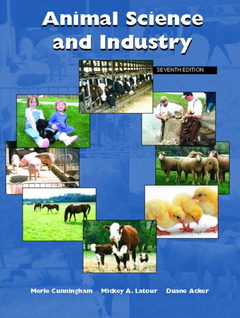Description
Animal science and industry (7th ed )
Authors: CUNNINGHAM Merle, ACKER Duane, LATOUR Mickey
Language: English
Subject for Animal science and industry (7th ed ):
Approximative price 120.22 €
Subject to availability at the publisher.
Add to cart
Publication date: 07-2004
784 p. · Hardback
784 p. · Hardback
Contents
/li>
1. Animal Agriculture. Global Trends in Animal Product Consumption. Changes in American Farm Population, Numbers, and Size. U.S. Land Resources. Why Are American Farmers So Productive? Animal Agriculture: The Role of Animals. The Gene Pool and Animal Classification. Animal Adaptation. Essential Factors of All Animal Enterprises. Characteristics of Specific Enterprises. Animal Agriculture, Animal Welfare, and Companion Animals. The Environment and Animal Waste Management. Questions for Study and Discussion. 2. The Animal Industry. Livestock and Poultry Density. The Animal Genetics Industry. The Feed Industry. Veterinarians and Animal Health. Facilities and Equipment. Markets. Processors. Restaurants and Food Retailers. The Animal Sciences. Government Agencies and Private Organizations. Questions for Study and Discussion. 3. Nutrients and Their Sources. Classes of Nutrients. How Nutrients May Be Used. Carbohydrates. Lipids: Fats and Oils. Proteins (Amino Acids). Water. Minerals. Vitamins. Nutrient Absorption and Formation by Plants. Feeds and Their Nutrient Content. Questions for Study and Discussion. 4. The Digestive and Metabolic Systems. Nonruminant Digestive System. Prehension, Mastication, and Salivation. Enzymatic Digestion. Absorption. Digestive System of the Horse. Ruminant Digestive System. Nutrient Transport. Nutrient Storage. Nutrient Utilization in the Cell. Questions for Study and Discussion. 5. Nutrition of Nonruminants. Nutrient Requirements. Recommended Nutrient Levels. Formulating Rations. Feeds and Their Effect on Consumption. Feed Additives. Nutritional Imbalances and Deficiencies. Other Species. Nutrition and the Newborn. Questions for Study and Discussion. 6. Nutrition of Ruminants. Nutrient Requirements. Factors Affecting Feed Intake. Formulating Daily Rations for Cows and Ewes. Rations for Finishing Cattle and Lambs. Dairy Calves and Growing Heifers (Herd Replacements). Dairy Cows. Questions for Study and Discussion. 7. Nutrition of Horses and Ponies. Nutrient Requirements. Feeds. Consumption and Influences. Nutrition and Performance. Pregnancy and the Foal. Other Feeding Management Precautions. Nutritional Deficiencies and Imbalances. Questions for Study and Discussion. 8. Evaluation of Feeder Animals. Inheritance and Range in Performing Ability. Feeder Cattle. Feeder Lambs. Feeder Pigs. Questions for Study and Discussion. 9. Animal Growth and Carcass Composition. Chronological Versus Physiological Growth. Measures of Growth. The Growth Curve and Its Phases. Hormonal Control of Growth. Factors Affecting Growth. Carcass Composition. Questions for Study and Discussion. 10. The Feeding Enterprise. Geographic Concentration. Feedlot Management. Capital and Costs. Influences on Animal Performance and Feedlot Profit. Profit Margin. Price Protection. Tax Considerations. Questions for Study and Discussion. 11. Animal Environment and Adaptation. Heat Loss and Heat Production. The Comfort Zone and Critical Temperature. Physiological Acclimatization to Temperature Stress. Controlling Heat Stress. Controlling Cold Stress. Ration Adjustments During Heat or Cold Stress. Other Environmental Factors. Ventilation. Flooring or Lot Surface. Space Requirements. Animal Waste Management. Questions for Study and Discussion. 12. Animal Health. Economic and Human Safety Concerns. Disease Defined and Classified. Predators and Injuries. Nutritional Deficiencies. Metabolic Disorders. Toxins and Poisons. Parasites and Protozoa. Types of Infectious Agents. Immunity and Vaccination. Reproductive and Respiratory Problems. Eradication and Repopulation Programs. Typical Herd Health Programs. Role of the Veterinarian. Diagnostic Services. Biosecurity. Questions for Study and Discussion. 13. Animal Behavior. Animal Behavior as a Science. Domestication and Genetic Influences on Behavior. Environmental Influences on Behavior. Physiology. Perception and the Sensory Systems. Learning and Training. Animal Communication. Understanding Animal Behavior. Group Behavior and Social Order. Grazing and Feeding Behavior. Sleeping and Resting Behavior. Sexual and Reproductive Behavior. Behavioral Problems and Abnormalities. Questions for Study and Discussion. 14. Physiology of Reproduction. Reproductive Performance and Profitability. The Male Reproductive System. The Female Reproductive System. Pregnancy. The Reproductive System in Domesticated Fowl. Artificial Insemination. Estrus Synchronization. Multiple Ovulation. Embryo Transplanting. Questions for Study and Discussion. 15. Management Regime and Reproductive Efficiency. Critical Nutrients for Reproduction. Growth and Development of Breeding Stock. Flushing and Other Nutritional Considerations. Other Influences on Conception. Nutritional Management During Pregnancy. Reproductive Efficiency in Poultry. Questions for Study and Discussion. 16. Lactation. Importance of Milk Production in Various Species. Hormonal Influences in Mammary Development and Lactation. Location, Number, and Appearance of Mammary Glands. Anatomy of the Udder. Milk Synthesis--Components of Milk. Rate of Milk Synthesis. Milk Let-Down. Nutrition and Milk Composition. Colostrum. Flavors and Odors. Appearance and Other Milk Quality Factors. Udder Health, Mastitis, and Mammary Gland Injuries. Questions for Study and Discussion. 17. Genetics. Genes and Chromosomes. Transmission of Genes. Single Gene Effects. Inheritance of Sex. Multiple Gene Effects. Cytoplasmic Inheritance. Genotype and Phenotype. Rules for Improvement by Selection. Genetic Variation. Examples of Genetic Improvement. Influence of Prolificacy and Generation Interval on Improvement Rate. Questions for Study Discussion. 18. Heritability and Genetic Improvement. Heredity Versus Environmental Influences. The Meaning of Heritability. Heritability of Individual Traits. Level of Heritability and Selection Effort. Methods to Improve Selection Accuracy. Predicting Rate of Improvement. Multiple-Trait Selection and Rate of Improvement. Questions for Study and Discussion. 19. Evaluation of Breeding Animals. Desirable Traits. Identification Systems. Recording Birth Dates. Importance of Records. Growth and Feed Efficiency Performance Records. Measuring Meatiness or Muscling. Reproduction Efficiency. Conform
© 2024 LAVOISIER S.A.S.

